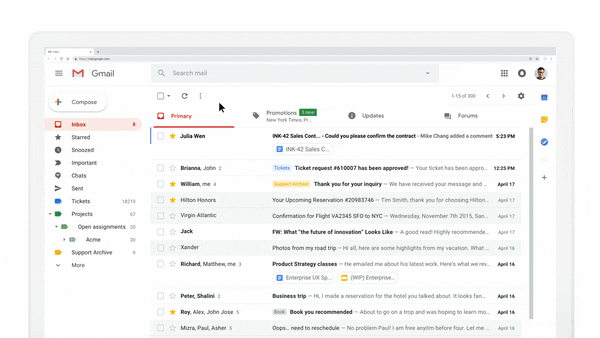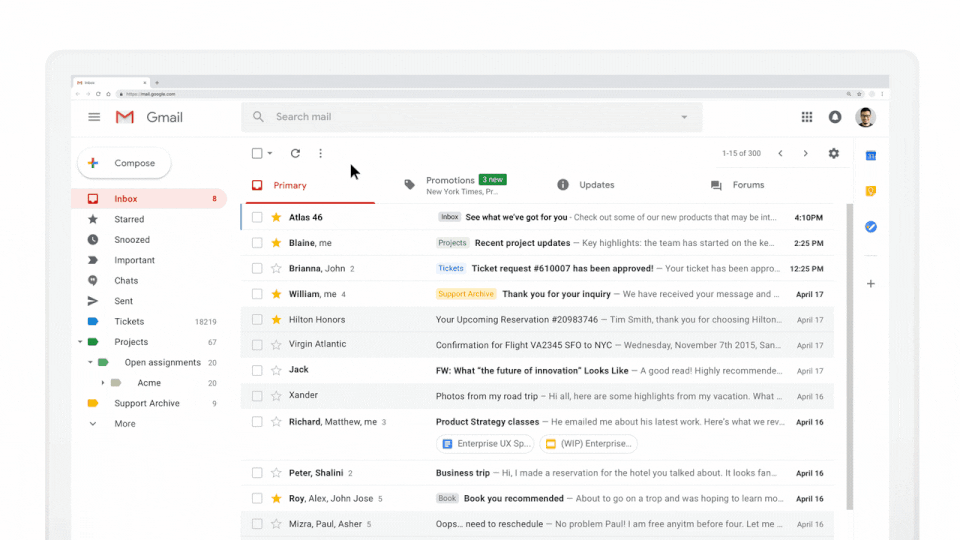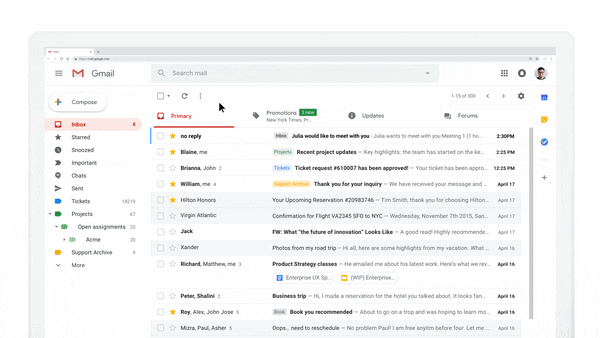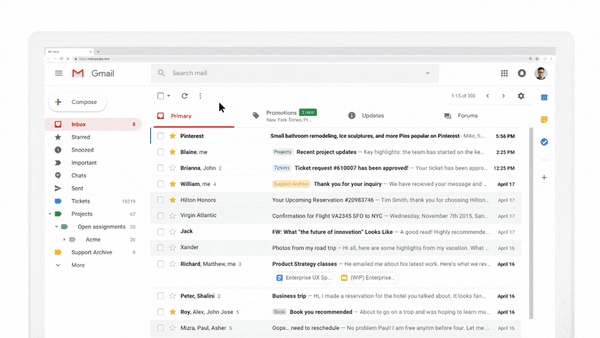It's already been more than a year since Google announced the arrival of AMP in emails (it was in February 2018 in Amsterdam)... and it's a topic we haven't discussed much on Badsender since then. So in light of the latest developments, it was time to right this wrong (well, that's a matter of opinion 😉 ).
AMP, for Accelerated Mobile Pages, is a technology developed by Google (but published in Open Source) originally promising to accelerate the display of pages on mobile. The idea is to create a new format, close to HTML, with new tags allowing to do without Javascript what we usually do with Javascript (there are all the tags described on the AMP website). Since then, a large part of the web has been criticizing Google (even if another part has joined in), considering that Google is technologically privatizing the World Wide Web... to serve its advertising ambitions! But that's not what we're talking about today.
What Google announced in February 2018 was. the arrival of AMP in Gmail. Why AMP in Gmail? Not because it would load emails faster, but because it would allow to use some of the AMP tags (and thus interactivity), without needing Javascript (which is banned in emails... and there is no reason for it to change for obvious security reasons). We'll come back to the advantages a little further on!
What we can say is that this announcement received very mixed reviews in the emailing community, mainly because of the "quasi-proprietary" aspect of the technology and the fact that Google announced an adoption by Gmail... but without the prospect of the techno being adopted by others... but that was before!

Gmail launches AMP to the general public
A little more than a year after the announcement in Amsterdam, Google has therefore made it known that AMP for email was now available for everyone! Well, when we say for all, it's not that simple, because in practice, you have to ask Google for approval (see here for instructions) and a whole series of criteria (which are not crazy either) must be met in order to start sending emails including an AMP version. Among these criteria, there is the obligation that the sending domain already has a minimum of regular traffic sent to Gmail servers, and especially low enough complaint rates. You will therefore need to have a good reputation with Gmail.
Another important criterion is to have an authentication SPF and DKIM valid. Moreover, as we will see in the technical part, having consistency in the use of your domain names becomes really critical. This is for security reasons and to ensure that AMP content can only come from clearly identified senders.
On the deployment level, it's underway for Gmail webmail, for Gmail mobile it will arrive soon (but we don't have the schedule yet) and for Gsuite (the new name of Google Apps... for a while now), administrators will be able to activate AMP for email in the administration interface as soon as the deployment is completed for their accounts.

After Gmail, it's Outlook, Yahoo and Mail.ru that are embarking on the adventure of AMP for email!
That AMP for email is officially deployed in Gmail is not really a surprise. But the most important announcement this week is finally than 3 other important webmails announce that they want to implement the technology: Outlook.com, Yahoo! and Mail.ru.
With Gmail, Outlook.com and Yahoo represent at least 50% of commercial emails sent to B2C targets in France (well, it may depend on your targets, especially in terms of age). So we go from a technology represented by a single actor, to a technology that will be made available to a majority of email boxes. This is enough to change the opinion of many detractors of AMP for email.
What the other 3 webmails have announced:
- Yahoo : The webmail announced that he was working on the subject on the brand new Verizon Postmaster. We can hope that AMP will not only concern Yahoo, but also AOL and Verizon.
- Outlook.com: Microsoft's announcement is a bit more comprehensive than Yahoo's as they announce a pre-release in summer 2019.
- Mail.ru: The Russian webmail is much more advanced than its two American counterparts since it is already possible to test its new version "Octavius". Mail.ru has also deployed a minisite dedicated to AMP on its postmaster page. We learn there (as for Gmail) that it is necessary that emails validate SPF, DKIM and DMARC.
What's in it for your messages?
Yes, because it's nice to talk about technology, technical stuff, to say that it's available now in Gmail and soon in others... but what's the point?
As you know, we have been trying to put interactivity in our emails for a long time. This is done through countdownsby modifying images according to external events (remember our advent calendar for email ?), by geolocation, quote detection, ... there are even some companies that have made it their specialty of real time in email, like Reelevant in France or LiveClicker and MovableInk.
Another trend is what is called Kinetic email, an attempt to push the possibilities ofhtml and css for email (whose possibilities are limited in some email clients) in order to bring interactivity to the messages: some email carousels, of the css animationmenus, status changes on mouse-over, tooltips, ...
The advantage of AMP compared to what we could do before? It's all built natively into the language! No more need for multiple hacks, no more need for a fallback solution for email clients that don't support certain techniques (well, in reality, we'll have to keep developing a 100% HTML version for a long time to come).
Some examples:
- Dynamically modify products or prices according to their availability at the time of the message consultation. This without having to use images, as this updated data can be contained in the text of the message (which is not the case with current techniques).
- New opportunities for multivariate testing techniques: as for the previous point, it will be relatively simple to vary the different parts of the same message according to the context and the performance generated by the previous openers.
- Create an email as if it were a mini-site/catalog: tabs, accordions, sliders, forms (with management of the sending of data and display of a confirmation message directly in the email) will make it possible to offer an interactive experience directly within the messages.
- We could go as far as imagining a chatbot in an email (we could start with a survey, but why make it simple?): Make people click, record data, confirm directly in the email, all this makes real interactions possible without having to leave the message. Ideal for example in the context of a customer service.
- ... count on us to invent (and test) uses that will enrich your customers' experience!
During the test phase, Google has already worked with some companies to imagine uses of AMP in email: Booking.com, Doodle, Pinterest, ...
Sample Doodle:

Pinterest Example:
Need help?
Reading content isn't everything. The best way is to talk to us.

In practice, there is a good chance that transactional and service emails will be the ones to see AMP usage grow. For cost reasons on the one hand (the investment is used for a long time), but also because these are the emails where the interaction possibilities will be the most valuable at first (confirmation without leaving the email, delivery status that updates itself, possibility to interact with an abandoned cart, ...).
Technical constraints: routers are not ready!
We get carried away, we get carried away, but today, the market for email routers and other campaign management solutions is not ready! Indeed, technically, there are important changes to make in their platforms, an additional format to manage in the email (AMP comes in addition to the HTML and text version), but also email design tools to invent to make the life of email creators easier.
At first, we will probably see relatively basic implementations before more complex uses emerge. As said before, transactional and service emails will probably benefit more from AMP at first since these messages are less dependent on routing solutions.
A few movements all the same (but mainly on US solutions):
- Sparkpost announces that they manage AMP in its sending API, that they manage AMP tracking and that they make AMP available in their templates.
- Sendgrid announces that it will be possible to send an AMP version via its APIs in the coming weeks.
- It is/will be possible to send AMP with Amazon SES and Pinpoint.
- Litmus announces that it is possible to test email previews using AMP in its suite and to use its builder to create AMP
We will ask the main French routers about this and we will keep you informed!
Technically how does it work?
As said above, AMP or Accelerated Mobile Pages is originally a format designed to accelerate the display of pages on mobile devices by having interactive possibilities without using Javascript. AMP for email therefore includes these possibilities of interactivity, but still limiting some of the tags.
At the email level, the most important technical constraint is that you have to add an additional MIME part to your messages. The AMP tags do not have to be added to your usual HTML code, but it is a second version that must be integrated.
So, in addition to your MIME "Content-Type: text/plain;" and your MIME "Content-Type: text/html;" you will need to add a 3ème with type "Content-Type: text/x-amp-html;".

For the curious, you can play with the sandbox set up on the AMP website.
On the constraint level, we already know a little more with the Gmail implementation. For example, the remote requests (XMLHttpRequests ) must have for destination the same domain as the one used to send the emails for security reasons. This presses the nail in the coffin of the necessary consistency of the domain names used for your sender identity (the deliverability is never far away in email marketing).
A few tags that seem instrumental in the adoption of the format:
- Retrieval of external data stored in JSON for example. The potential is "huge"! Do not hesitate to go and see the doc for the tag> ;
- Changing the content/appearance by clicking on elements: changing image size, changing content, changing CSS properties. Go to the doc of the <AMP-BIND>;
- The creation of forms via the <AMP-FORM>;
- And many others like <AMP-ACCORDION> or even <AMP-CAROUSEL>
There is an introductory documentation that covers the basics of the technique for email.
Have fun!
What's next?
For the most motivated, perhaps we will know more during the AMP Conference in Tokyo on April 17 and 18. If you are there, let us know 😉
We will ask the campaign management solutions in France what their plans are for AMP, we will keep you posted.
We will obviously do some experiments (and share them with you) but also dig into the marketing aspects. A technology is all very well, but you still have to think about its use so that it is the most relevant for the recipients of your messages.
Finally, we will keep you informed of the evolution of the implementations in routers and webmails.
If, as an advertiser, you'd like us to help you see the potential of AMP for email for your messages, and who knows, start an initial experiment in the field, don't hesitate to call on the services of our agency. contact us.
Leave a Reply